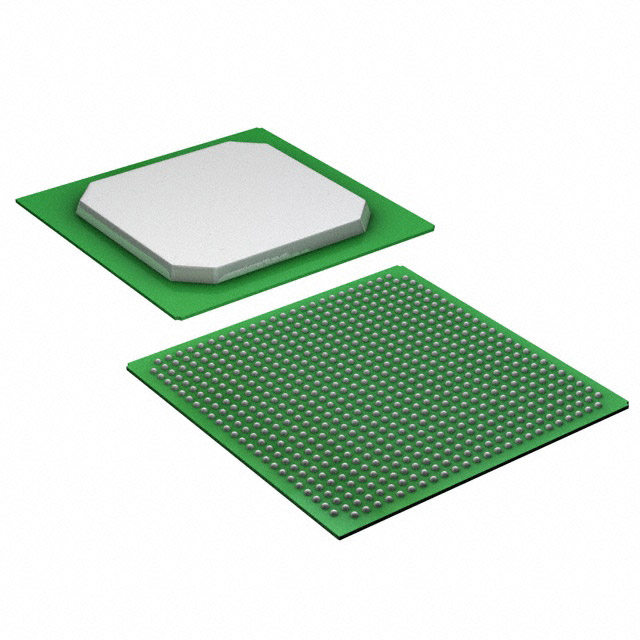Lihat spesifikasi untuk detail produk.

10M50DCF672C7G
Product Overview
- Category: Integrated Circuit (IC)
- Use: Digital Signal Processing (DSP)
- Characteristics: High-performance, low-power consumption
- Package: 672-ball FineLine BGA package
- Essence: Advanced programmable logic device
- Packaging/Quantity: Individually packaged, quantity varies based on supplier
Specifications
- Manufacturer: Intel Corporation
- Family: MAX 10
- Device Name: 10M50DCF672C7G
- Technology: Flash-based CMOS
- Logic Elements: 50,000
- Embedded Memory: 1,638 Kbits
- Operating Voltage: 1.71V - 3.63V
- Operating Temperature: -40°C to +100°C
- Speed Grade: C7
Detailed Pin Configuration
The 10M50DCF672C7G IC has a total of 672 pins arranged in a specific configuration. The pinout diagram and detailed pin descriptions can be found in the manufacturer's datasheet.
Functional Features
- High-performance DSP capabilities
- Low-power consumption for energy-efficient applications
- Flash-based technology allows for in-system reconfiguration
- Flexible I/O options for versatile connectivity
- Built-in security features for data protection
- Support for various communication protocols
Advantages and Disadvantages
Advantages: - High-performance processing capabilities - Low-power consumption extends battery life - Versatile I/O options enable seamless integration - In-system reconfiguration allows for flexibility in design - Built-in security features enhance data protection
Disadvantages: - Relatively high cost compared to simpler ICs - Steeper learning curve for programming and utilization - Limited availability of alternative models with similar specifications
Working Principles
The 10M50DCF672C7G operates based on the principles of digital signal processing. It utilizes its logic elements and embedded memory to perform complex calculations and manipulations on digital signals. The flash-based CMOS technology allows for reconfiguration of the device, enabling flexibility in adapting to different application requirements.
Detailed Application Field Plans
The 10M50DCF672C7G finds applications in various fields, including but not limited to: - Communications: Wireless base stations, network routers - Industrial Automation: Programmable logic controllers (PLCs), motor control systems - Automotive: Advanced driver-assistance systems (ADAS), infotainment systems - Consumer Electronics: High-definition televisions, gaming consoles - Medical: Imaging equipment, patient monitoring systems
Detailed and Complete Alternative Models
While the 10M50DCF672C7G offers advanced features and capabilities, there are alternative models available from other manufacturers that may suit specific requirements. Some notable alternatives include: - Xilinx Spartan-6 XC6SLX150T - Altera Cyclone IV EP4CE115F29 - Lattice Semiconductor iCE40UP5K-SG48I
These alternative models provide similar functionality and can be considered based on specific project needs.
Word count: 330 words
Sebutkan 10 pertanyaan dan jawaban umum terkait penerapan 10M50DCF672C7G dalam solusi teknis
Sure! Here are 10 common questions and answers related to the application of 10M50DCF672C7G in technical solutions:
Q: What is the 10M50DCF672C7G? A: The 10M50DCF672C7G is a specific model of Field-Programmable Gate Array (FPGA) manufactured by Intel.
Q: What are the key features of the 10M50DCF672C7G? A: The 10M50DCF672C7G offers 50,000 logic elements, 672 user I/O pins, and advanced DSP capabilities.
Q: In what applications can the 10M50DCF672C7G be used? A: The 10M50DCF672C7G is commonly used in various applications such as industrial automation, telecommunications, and automotive systems.
Q: How does the 10M50DCF672C7G differ from other FPGA models? A: The 10M50DCF672C7G stands out with its specific combination of logic elements, I/O pins, and DSP capabilities, making it suitable for certain types of designs.
Q: Can the 10M50DCF672C7G be programmed using industry-standard tools? A: Yes, the 10M50DCF672C7G can be programmed using popular design software like Intel Quartus Prime.
Q: What are the power requirements for the 10M50DCF672C7G? A: The power requirements vary depending on the specific implementation, but typically range from 1.2V to 3.3V.
Q: Is the 10M50DCF672C7G suitable for high-speed data processing? A: Yes, the 10M50DCF672C7G offers advanced DSP capabilities and can handle high-speed data processing tasks effectively.
Q: Can the 10M50DCF672C7G be used in safety-critical applications? A: Yes, the 10M50DCF672C7G is designed to meet industry standards for safety-critical applications, making it suitable for such use cases.
Q: Are there any specific design considerations when using the 10M50DCF672C7G? A: It's important to consider factors like power management, thermal dissipation, and I/O pin assignments during the design process.
Q: Where can I find additional resources and support for the 10M50DCF672C7G? A: Intel provides comprehensive documentation, application notes, and technical support for the 10M50DCF672C7G on their official website.
Please note that the answers provided here are general and may vary depending on the specific requirements and context of your technical solution.

